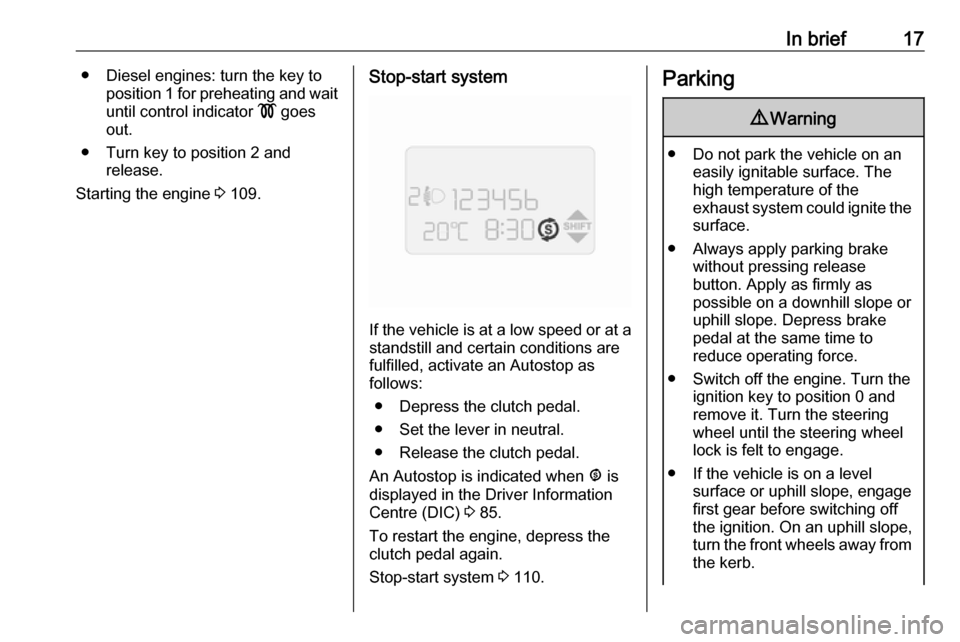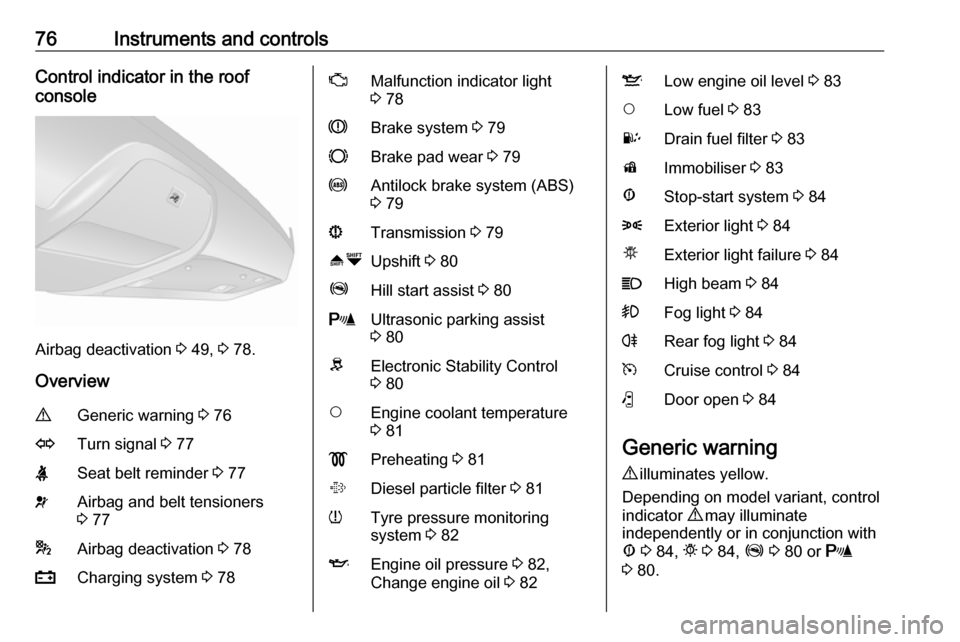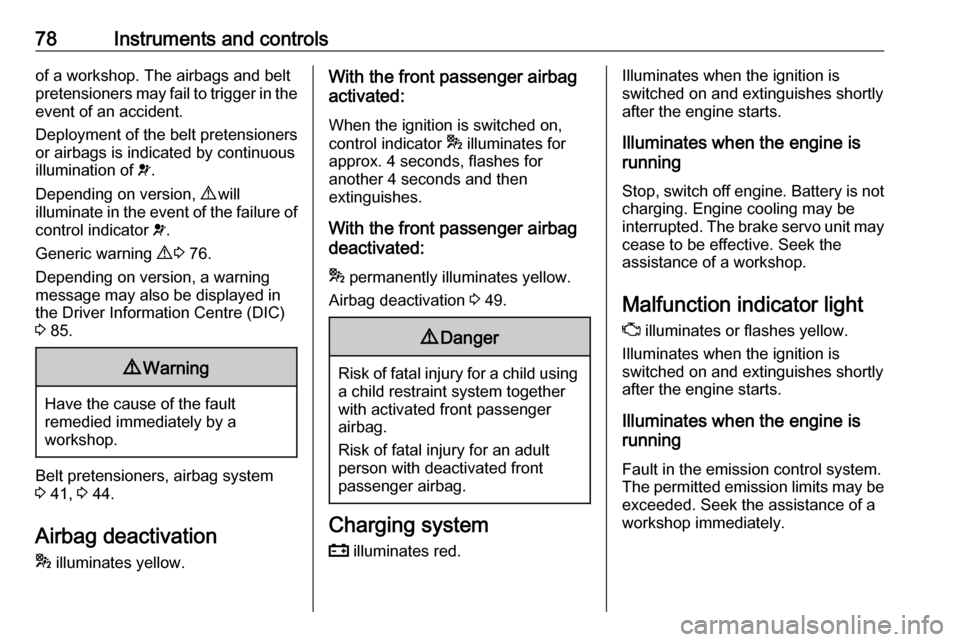brake VAUXHALL COMBO 2016 Owner's Manual
[x] Cancel search | Manufacturer: VAUXHALL, Model Year: 2016, Model line: COMBO, Model: VAUXHALL COMBO 2016Pages: 189, PDF Size: 4.47 MB
Page 18 of 189

16In briefManual transmission automatedN:neutral positiono:drive position+:higher gear-:lower gearA/M:switch between automatic and
manual modeR:reverse gear (with selector
lever lock)
Manual transmission automated
3 115.
Starting off
Check before starting-off ● Tyre pressure and condition 3 151, 3 179.
● Engine oil level and fluid levels 3 135.
● All windows, mirrors, exterior lighting and number plates are
free from dirt, snow and ice and
are operational.
● Proper position of mirrors, seats, and seat belts 3 28, 3 33,
3 42.
● Brake function at low speed, particularly if the brakes are wet.Starting the engine
● Turn key to position 1.
● Move the steering wheel slightly to release the steering wheel
lock.
● Operate clutch and brake.
● Manual transmission automated: operate brake, the transmission
automatically shifts to N (neutral).
● Do not operate accelerator pedal.
Page 19 of 189

In brief17● Diesel engines: turn the key toposition 1 for preheating and wait
until control indicator ! goes
out.
● Turn key to position 2 and release.
Starting the engine 3 109.Stop-start system
If the vehicle is at a low speed or at a
standstill and certain conditions are
fulfilled, activate an Autostop as
follows:
● Depress the clutch pedal.
● Set the lever in neutral.
● Release the clutch pedal.
An Autostop is indicated when ^ is
displayed in the Driver Information
Centre (DIC) 3 85.
To restart the engine, depress the
clutch pedal again.
Stop-start system 3 110.
Parking9 Warning
● Do not park the vehicle on an
easily ignitable surface. The
high temperature of the
exhaust system could ignite the
surface.
● Always apply parking brake without pressing release
button. Apply as firmly as
possible on a downhill slope or
uphill slope. Depress brake
pedal at the same time to
reduce operating force.
● Switch off the engine. Turn the ignition key to position 0 and
remove it. Turn the steering
wheel until the steering wheel
lock is felt to engage.
● If the vehicle is on a level surface or uphill slope, engage
first gear before switching off
the ignition. On an uphill slope,
turn the front wheels away from
the kerb.
Page 65 of 189

Storage63● The load must not obstruct theoperation of the pedals, parking
brake and gear selector, or
hinder the freedom of movement of the driver. Do not place any
unsecured objects in the interior.
● Do not drive with an open load compartment.9Warning
Always make sure that the load in
the vehicle is securely stowed.
Otherwise objects can be thrown
around inside the vehicle and
cause personal injury or damage
to the load or vehicle.
● The payload is the difference between the permitted gross
vehicle weight (see identification
plate 3 170) and the EC kerb
weight.
To calculate the payload, enter
the data for your vehicle in the
Weights table at the front of this
manual.
The EC kerb weight includes
weights for the driver (68 kg),
luggage (7 kg) and all fluids (tank 90% full).
Optional equipment and
accessories increase the kerb
weight.
● Driving with a roof load increases
the sensitivity of the vehicle to
cross-winds and has a
detrimental effect on vehicle
handling due to the vehicle's
higher centre of gravity.
Distribute the load evenly and secure it properly with retaining
straps. Adjust the tyre pressure
and vehicle speed according to
the load conditions. Check and
retighten the straps frequently.
Do not drive faster than 75 mph.
The permissible roof load (which includes the weight of the roof
rack) is 100 kg. The roof load is
the combined weight of the roof
rack and the load.
Page 66 of 189

64Instruments and controlsInstruments and
controlsControls ....................................... 65
Steering wheel adjustment ........65
Steering wheel controls .............65
Horn ........................................... 65
Windscreen wiper/washer .........66
Rear window wiper/washer .......66
Headlamp washer .....................67
Outside temperature ..................67
Clock ......................................... 67
Power outlets ............................. 68
Cigarette lighter ......................... 69
Ashtrays .................................... 70
Warning lights, gauges and indi‐ cators ........................................... 70
Instrument cluster ......................70
Speedometer ............................. 70
Odometer .................................. 70
Trip odometer ............................ 70
Tachometer ............................... 71
Fuel gauge ................................ 71
Fuel selector .............................. 72
Engine coolant temperature gauge ....................................... 72
Service display .......................... 73Transmission display .................73
Control indicators ......................73
Generic warning ........................76
Turn signal ................................. 77
Seat belt reminder .....................77
Airbag and belt tensioners .........77
Airbag deactivation ....................78
Charging system .......................78
Malfunction indicator light ..........78
Brake system ............................. 79
Brake pad wear ......................... 79
Antilock brake system (ABS) .....79
Transmission ............................. 79
Upshift ....................................... 80
Hill start assist ........................... 80
Ultrasonic parking assist ...........80
Electronic Stability Control ........80
Engine coolant temperature ......81
Preheating ................................. 81
Diesel particle filter ....................81
Tyre pressure monitoring system ...................................... 82
Engine oil pressure ....................82
Change engine oil .....................82
Low engine oil level ...................83
Low fuel ..................................... 83
Drain fuel filter ........................... 83
Immobiliser ................................ 83
Stop-start system ......................84
Exterior light .............................. 84High beam................................. 84
Fog light ..................................... 84
Rear fog light ............................. 84
Cruise control ............................ 84
Door open .................................. 84
Information displays .....................85
Driver Information Centre ..........85
Vehicle messages ........................90
Warning chimes .........................90
Fuel system messages ..............91
Trip computer ............................... 91
Page 78 of 189

76Instruments and controlsControl indicator in the roof
console
Airbag deactivation 3 49, 3 78.
Overview
9Generic warning 3 76OTurn signal 3 77XSeat belt reminder 3 77vAirbag and belt tensioners
3 77*Airbag deactivation 3 78pCharging system 3 78ZMalfunction indicator light
3 78RBrake system 3 79FBrake pad wear 3 79uAntilock brake system (ABS)
3 79sTransmission 3 79[ ÒUpshift 3 80ZHill start assist 3 80rUltrasonic parking assist
3 80RElectronic Stability Control
3 80$Engine coolant temperature
3 81!Preheating 3 81%Diesel particle filter 3 81wTyre pressure monitoring
system 3 82IEngine oil pressure 3 82,
Change engine oil 3 82SLow engine oil level 3 83$Low fuel 3 83UDrain fuel filter 3 83dImmobiliser 3 83ÆStop-start system 3 848Exterior light 3 84µExterior light failure 3 84CHigh beam 3 84>Fog light 3 84rRear fog light 3 84mCruise control 3 84(Door open 3 84
Generic warning
9 illuminates yellow.
Depending on model variant, control
indicator 9 may illuminate
independently or in conjunction with
Æ 3 84, t 3 84, Z 3 80 or r
3 80.
Page 80 of 189

78Instruments and controlsof a workshop. The airbags and belt
pretensioners may fail to trigger in the
event of an accident.
Deployment of the belt pretensioners
or airbags is indicated by continuous
illumination of v.
Depending on version, 9 will
illuminate in the event of the failure of
control indicator v.
Generic warning 9 3 76.
Depending on version, a warning
message may also be displayed in
the Driver Information Centre (DIC)
3 85.9 Warning
Have the cause of the fault
remedied immediately by a
workshop.
Belt pretensioners, airbag system
3 41, 3 44.
Airbag deactivation
* illuminates yellow.
With the front passenger airbag
activated:
When the ignition is switched on, control indicator * illuminates for
approx. 4 seconds, flashes for
another 4 seconds and then
extinguishes.
With the front passenger airbag
deactivated:
* permanently illuminates yellow.
Airbag deactivation 3 49.9 Danger
Risk of fatal injury for a child using
a child restraint system together
with activated front passenger
airbag.
Risk of fatal injury for an adult
person with deactivated front
passenger airbag.
Charging system
p illuminates red.
Illuminates when the ignition is
switched on and extinguishes shortly
after the engine starts.
Illuminates when the engine is
running
Stop, switch off engine. Battery is not
charging. Engine cooling may be
interrupted. The brake servo unit may cease to be effective. Seek the
assistance of a workshop.
Malfunction indicator light
Z illuminates or flashes yellow.
Illuminates when the ignition is
switched on and extinguishes shortly
after the engine starts.
Illuminates when the engine is
running
Fault in the emission control system.The permitted emission limits may be
exceeded. Seek the assistance of a
workshop immediately.
Page 81 of 189

Instruments and controls79Flashes when the engine is
running
Fault that could lead to catalytic
converter damage. Ease up on the accelerator until the flashing stops.
Seek the assistance of a workshop
immediately.
Depending on version, a warning
message may also be displayed in
the Driver Information Centre (DIC)
3 85.
Brake system
R illuminates red.
Illuminates after the ignition is
switched on if the parking brake is
applied 3 119. A warning chime will
sound if a certain speed is exceeded
with the parking brake applied.
Illuminates when the parking brake is
released if the brake fluid level is too
low 3 137.9 Warning
Stop. Do not continue your
journey. Consult a workshop.
Illuminates if the brake vacuum servo
fails; the brake pedal becomes stiff
when pressed. The brake system
remains operational however,
assistance will be reduced. The
steering may also require
considerably more effort when
turning.
Depending on version, a warning
message may also be displayed in
the Driver Information Centre (DIC) 3 85.
Brake pad wear
F illuminates yellow.
The front brake pads are worn, seek
the assistance of a workshop
immediately.
Depending on version, a warning
message may also be displayed in
the Driver Information Centre (DIC)
3 85.
Antilock brake system
(ABS)
u illuminates yellow.Illuminates for a few seconds after the
ignition is switched on. The system is
ready for operation when the control
indicator extinguishes.
If the control indicator does not
extinguish after a few seconds, or if it illuminates while driving, there is a
fault in the ABS. The brake system
remains operational but without ABS
regulation.
If u illuminates together with R,
there is a fault in the braking system.
Depending on version, a warning
message may also be displayed in
the Driver Information Centre (DIC)
3 85. Seek the assistance of a
workshop immediately.
Antilock brake system 3 119.
Transmission
s illuminates red.
Illuminates for a few seconds after the ignition is switched on.
s illuminates during driving when a
fault is present in the transmission.
Page 82 of 189

80Instruments and controlsA warning message may also appear
in the Driver Information Centre (DIC)
3 85 in conjunction with a warning
chime.
Continued driving is possible,
provided the vehicle is driven with
care and anticipation.
Have the cause of the fault remedied
by a workshop as soon as possible.
Manual transmission automated
3 115.
Upshift
[ or Ò illuminates green in the
Driver Information Centre (DIC)
3 85 when gearshifting is
recommended to improve fuel
economy.
Hill start assistZ illuminates yellow.
Illuminates for a few seconds after the ignition is switched on.
If the control indicator does not
extinguish after a few seconds, or if it
illuminates while driving, there is afault in the Hill start assist. Seek the
assistance of a workshop to have the
fault remedied.
The Electronic Stability Control (ESC) control indicator R may also
illuminate 3 80 in conjunction with
Z .
Depending on version, 9 may
illuminate as an alternative if control
indicator Z is not present, in
conjunction with a warning message
in the Driver Information Centre (DIC)
3 85.
Generic warning 9 3 76.
Hill start assist 3 120.
Ultrasonic parking assist r illuminates yellow.
Fault in system
or
Fault due to sensors that are dirty or
covered by ice or snow
orInterference due to external sources
of ultrasound. Once the source of
interference is removed, the system
will operate normally.
Have the cause of the fault in the
system remedied by a workshop.
Control indicator 9 will illuminate as
an alternative if control indicator r
is not present. Depending on version,
a warning message may also be
displayed in the Driver Information
Centre (DIC) 3 85.
Generic warning 9 3 76.
Ultrasonic parking assist 3 124.
Electronic Stability Control
R illuminates or flashes yellow.
Illuminates for a few seconds after the
ignition is switched on. The system is ready for operation when the control
indicator extinguishes.
Flashes during driving
The system is actively engaged.
Engine output may be reduced and the vehicle may be braked
automatically to a small degree.
Page 84 of 189

82Instruments and controlsControl indicator % illuminates when
diesel particle filter is full. Start
cleaning process as soon as possible
to avoid damage to the engine.
Diesel particle filter 3 113, Stop-start
system 3 110.
Tyre pressure monitoring
system
w illuminates or flashes yellow.
Illuminates
Tyre pressure loss. Stop immediately
and check tyre pressure.
Control indicator w illuminates
together with a warning chime and, in
vehicles with Multifunction version of
the Driver Information Centre (DIC) 3 85, a corresponding message
also appears when a puncture or
severely under-inflated tyre is
detected.
Flashes
Fault in system. After several
seconds w illuminates continuously.
Consult a workshop.Depending on version, a
corresponding message also
appears in the DIC when a tyre
without a pressure sensor is mounted (e.g. spare wheel).
Tyre pressure monitoring system
3 151.
Engine oil pressure
I illuminates red.
Illuminates when the ignition is
switched on and extinguishes shortly
after the engine starts.
Illuminates when the engine is
running
Depending on version, a warning
message may also be displayed in
the Driver Information Centre (DIC) 3 85.Caution
Engine lubrication may be
interrupted. This may result in
damage to the engine and/or
locking of the drive wheels.
1. Depress clutch.
2. Select neutral gear (or move selector lever to N).
3. Move out of the flow of traffic as quickly as possible without
impeding other vehicles.
4. Switch off ignition.9 Warning
When the engine is off,
considerably more force is needed
to brake and steer. During an
Autostop the brake servo unit will
still be operational.
Do not remove key until vehicle is
stationary, otherwise the steering wheel lock could engage
unexpectedly.
Check oil level before seeking the
assistance of a workshop 3 135.
Change engine oil
Diesel engines with diesel particle filter
I flashes red.
Page 92 of 189

90Instruments and controlsappears in the display. Select YES (to
confirm changes) or No (to cancel
changes).
Airbag deactivation 3 49.
DAYTIME RUNNING LIGHTS
Activate the daytime running lights to
increase visibility of the vehicle during daylight (set to On). Deactivate when
not required (set to Off).
Daytime running lights 3 95.
EXIT MENU
Select this menu option to exit the
settings menu.Vehicle messages
Warning chimes Only one warning chime will sound at
a time.
The warning chime regarding
unfastened seat belts has priority
over any other warning chime.
When starting the engine or whilst
driving
● If seat belt is not fastened.
● If a certain speed is exceeded with the parking brake applied.
● If the parking assist detects an object.
● If a fault is detected in the parking
assist.
● If a door, the bonnet or the tailgate is not fully closed when
starting-off.
● If the vehicle speed briefly exceeds a set limit.
● If the stop-start system cannot restart the engine automatically.● Vehicles with manual transmission automated; brake
pedal has not been depressed
when starting the engine.
● Vehicles with manual transmission automated; an
incorrect gear has been selected when starting-off or during
driving.
● Vehicles with manual transmission automated; whenthe vehicle is at a standstill, if
engine is running and a gear is
engaged; transmission
automatically shifts to N in certain
situations.
● If the clutch temperature is too high in vehicles with manual
transmission automated.
● If a transmission fault is detected
in vehicles with manual
transmission automated.
● If a warning message, e.g. low tyre pressure, appears in the
Driver Information Centre (DIC).